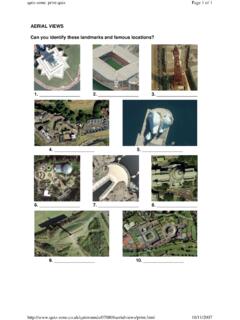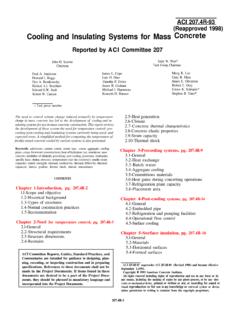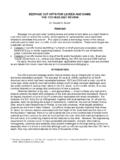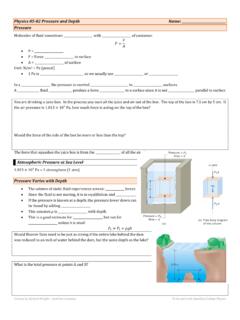Transcription of A Colorado River Sediment Inventory
1 A Colorado RiverSediment InventoryCompiled by John WeisheitThe table below is a compilation of scientific data fromreports written by hydrologists. For the US GeologicalSurvey (USGS) Eugene LaRue documented the sedimentloads of the Colorado River in early Water Supply very comprehensive study on Sediment in Lake Meadreservoir was conducted by the USGS in 1948-49 andpublished in 1960 as Professional Paper #295. This paperset the standard for the study of sedimentation in largereservoirs that has yet to be repeated. Subsequent studies,but limited in scope, have been accomplished such as the1986 Lake Powell Survey by the Bureau of Reclamation,and an excellent report was written by Edmund D. Andrewsof the USGS, Sediment Transport in the Colorado RiverBasin, which was published in 1991 by the NationalAcademy of Sciences.
2 Unfortunately, the collection of datafor Sediment was discontinued by the USGS in chart below is basically accurate in all columnsand rows. Two points of climate history must be consideredwhen reviewing this data: 1) Sediment loads varyconsiderably due to changes in climate regimes; 2) sincethe construction of Hoover Dam, additional reservoirs havebeen added to the plumbing system, which are collectingsediment independently throughout the entire , all River sections between dams have had theirsediment loads government scientists who studied thesedimentation of Lake Mead in 1948 were actually alarmedat the rapid accumulation of Sediment in that reservoir. Tomitigate the problem, and to their chagrin, theyrecommended the building of upper basin dams. Thoughthis provided more longevity for Lake Mead, it essentiallyspread the Sediment problem to more than one place andeffectively increased future mitigation costs demonstrates the mismanagement of water resourcesin the Colorado River basin, which can be summarizedbest as stealing the future to gain the the studies show is that Sediment transport inthe Colorado River itself has been greatly reduced since1942 and by as much as 400%.
3 This does not necessarilymean that natural erosion on the Colorado Plateau is atrest. More likely, Sediment is being stored in the arroyos ofthe basin and waiting for threshold events to transport theirloads into the Colorado River , and subsequently intomainsteam reservoirs such as Mead and example, a flood with a peak discharge of 140,000cfs roared through San Juan Canyon below Mexican Hat,Utah in October 1911. It is just a matter of time beforesimilar flood events mobilize many decades worth ofsediment from arroyos and send huge plugs of sedimentinto Lake Sediment management plan must be conducted inthe very near future by the Bureau of Reclamation. Thisstudy must not only evaluate the Sediment of all themainstem reservoirs of the Colorado River and itstributaries, but it must also evaluate the storage of sedimentin all the ephemeral arroyos, especially where softMesozoic rocks dominate the landscape such as the basinsof the San Juan and Little Colorado rivers.
4 It must alsodetermine the effects that Sediment will have on dam safety,power generation, water storage, recreation, and themanagement of endangered Much Sediment Are We Talking About?According to E. D. Andrews very reasonable estimate,which was published in 1990, there are 44,400,000 tonsof Sediment arriving intoLake Powell reservoir on ayearly basis under the cur-rent climate regime. A truckpulling a street legal load hasa carrying capacity of 22tons. In one year, it would re-quire million truckloads to remove the annualsediment load of LakePowell. That is 5,529 truckloads per day; 230 loads perhour; 4 loads per scenario demon-strates very well the costsand impacts involved in solv-ing the Sediment problem ofreservoirs. It also destroysthe myth that federal damsare cost-effective and thathydropower is a greatest interest centered in the rate of sedimentmovement in the Rio Grande and Colorado River basins,perhaps the two streams most heavily laden with sedimentin the country.
5 Reports by Stabler (1911), Follett (1913),and Fortier and Blaney (1928) are the best known studiesof Sediment load in these two streams. The early estimatesof Sediment movement appear to be surprisingly good andreflect the ability and good judgment of those engaged inthe early development of the water resources of the the light of more recent data, the estimates of aver-age Sediment load were generally somewhat high, and thepredictions of reservoir life thus appear to be conserva-tive. In 1899, the Sediment load of the Gila River at SanCarlos, Ariz., was estimated to average 8,440 acre-feetper year, but the observed rate of deposition in San CarlosReservoir on the Gila River in the period 1928-47 was 3,200acre-feet per year. In 1913, the average annual sedimentload of the Rio Grande at Elephant Butte Reservoir, , was estimated to be 19,700 acre-feet; the observedrate of accumulation in Elephant Butte Reservoir in 1915-47was 14,400 acre-feet per year.
6 Prior to the construction ofHoover Dam the Sediment load of the Colorado River wasestimated to be 137,000 acre-feet per year, but the 1948-49survey has shown the average annual rate of accumula-tion to have been about 102,000 acre-feet. In nearly allcases present estimates promise a greater length of lifefor major western reservoirs than those made prior to encouraging news does not allay the problem ofsedimentation in reservoirs, but merely puts off the day ofreckoning. Commonly sedimentation is a minor problemduring the first years of operation of a reservoir, but as thewater-storage facility is used by succeeding generationsthe problem becomes of progressively greater significanceand concern. Sooner or later the water users ask the ques-tions: How long will the reservoir continue to be of use toTHE Sediment PROBLEM IN RESERVOIRSby Thomas L.
7 Maddock, Bureau of ReclamationA chapter from: Comprehensive Survey of Sedimenta-tion in Lake Mead, 1948-1949, USGS Professional Paper295; W. O. Smith, C. P. Vetter, G. B. Cummings, et. accumulation of Sediment in reservoirs has longbeen recognized as one of the principal problems in-volved in the Western United States in providing for regu-lation of rivers by storage. Even the rivers in humid re-gions carry some Sediment , and in several reservoirs inthe eastern half of the country the accumulation of sedi-ment is a significant engineering problem. More than 50years ago F. H. Newell of the Geological Survey, later tobecome the first Director of the Reclamation Service [nowcalled Bureau of Reclamation] wrote: Thus, the upper endsof all reservoirs are rapidly filled with silt and it becomesan important question to the projectors of storage worksas to how many years will elapse before the value of thereservoir is practically destroyed and whether its use canbe restored in part by subsequent removal of some of thismaterial.
8 To answer part of the question posed by Newell, theGeological Survey undertook, from 1904 to about 1910,what today would be called a miscellaneous Sediment sam-pling program on many streams in the West, particularlythose whose load of Sediment was obviously great. For along time records collected during this period formed thebasis for estimates of the Sediment load of western streams,and such estimates in turn provided the basis for deci-sions as to the amount of reservoir capacity to allocate tosediment storage and for estimates of the useful life ofproposed ; what can be done to increase that economic life; willthere be diminution or deterioration of their water supplies(and, if so, when and how much); and what alternativesare available for meeting their continuing requirements?These questions cannot be answered merely from ananalysis of records of the rate of movement of sedimentinto reservoirs, even if those records were complete andaccurate, which they are not.
9 Also, detailed information isessential as to the mechanics of transportation and depo-sition of sediments in reservoirs, which is obtained by com-prehensive surveys such as the one undertaken in LakeMead during 1948-49. In part, the answers would dependupon an understanding of the dynamics of sedimentation,including erosion and transportation in the tributary water-shed, as well as deposition in the is difficult to predict theuseful life of a reservoir evenif the rate of Sediment move-ment into the reservoir isknown. This difficulty comesabout partly because therate of Sediment movementin streams is measured byweight, and the weight of thesediment must be convertedinto space occupied. Theconversion factor as foundby reservoir surveys is notconstant because the sedi-ment becomes more com-pact as it dries and as depos-its deepen.
10 The space occupied by a given weight of sedi-ment, therefore, will vary with the type of reservoir opera-tion and the age of the reservoir. This is one of the rea-sons why successive volumetric surveys of a reservoir tendto show decreasing rates of Sediment the United States there is no experience to guideany estimate of how rapidly a large reservoir will fill to thelast stages of its life. It is known that, as the capacity of areservoir diminishes, more of the Sediment load passesthrough without being deposited. It is known also that, asdeposition in a reservoir proceeds, a considerable quan-tity of Sediment is deposited upstream from the flow line ofthe reservoir. Here again experience is not yet a sufficientguide to a determination of the amount of Sediment thatwill be deposited in such locations. Critical problems canresult from upstream deposition, and some have been ob-served.






